Which of the following criteria is used to assess SIRS in patients?
- body temperature
- blood glucose
- serum electrolytes
- Urine output
Body temperature
criteria includes: body temperature, HR, respiratory rate, WBCs
A 72 year old patient arrives with a complaint of an infected cat bite on her left hand. The third finger is red, swollen, and tender. The patient has a history of COPD, uses albuterol as needed, takes aspirin daily and has no known drug allergies.
How many resources do you predict?
- 2 or more
- 0
- 1
2 or more resources
Some resources to consider:
- XR
- IV antibiotics
- Labs
A 52 year old male is admitted with fever, cough and pleuritic pain with following vitals:
- Respiratory rate: 21/min
- Oxygen saturation: 93%
- On air
- Systolic blood pressure: 120 mmHg
- Heart rate : 95/min
- Consciousness: Alert
- Temperature: 38.5 °C
What is the patients NEWS2 score?
NEWS2 = 6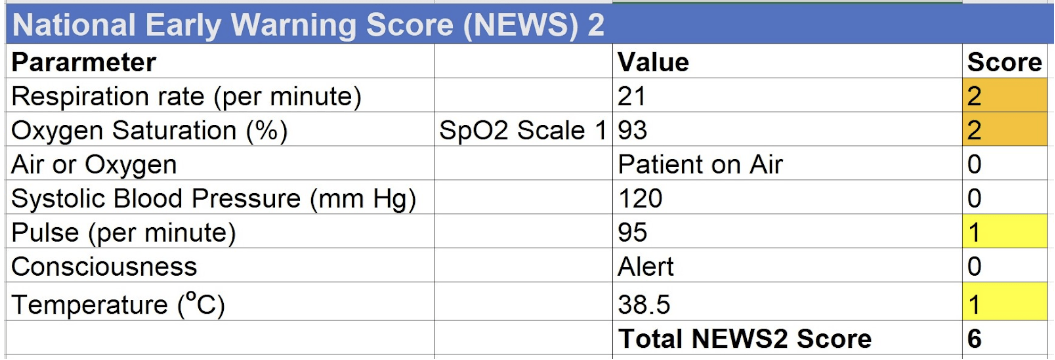
a 25 year old female is in the urgent care with a MEOWS score of 5.
How should the nurse proceed?

What are the three categories included in the pediatric assessment triangle?
Appearance, breathing, circulation
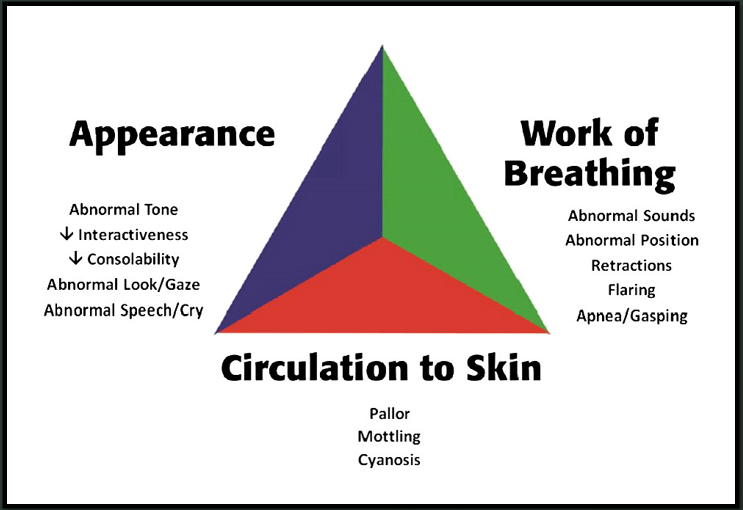
A nurse is evaluating a patient for possible severe sepsis. Which of the following lab findings is most suggestive of organ dysfunction?
- Elevated WBC
- Decreased platelet
- Normal serum lactate level
- Increased serum bilirubin level
Increased serum bilirubin
can indicate liver dysfunction, commonly observed in severe sepsis due to systemic inflammation and impaired perfusion.
a 60 year old male presents with a complaint of dark stools for 8 days with vague abdominal pains. He denies any past medical history. His skin is pale and diaphoretic.
VS: HR 140, BP 80 by palpation, RR 22, SaO2 96% RA
What ESI would you assign the patient?
ESI 1
The patient requires immediate hemodynamic stabilization considering HR, BP, and symptoms of paleness and diaphoresis. Tachycardia and hypotension may indicate blood loss.
A 71 year old male with COPD is post op with fever, cough and chest pain with following vitals:
- Respiratory rate: 26/min
- Oxygen saturation: 94%
- Oxygen
- Systolic blood pressure: 89 mmHg
- Heart rate: 145/min
- Consciousness: Confused
- Temperature: 38.3 °C
What is the patients NEWS2 score?
NEWS2 = 16

How often should the nursing team reassess a MEOWS for a patient with a score of 2?
Every shift or at least 12 hours

A PEWS score of what number warrants immediate intervention and transfer to a resuscitation room?
8
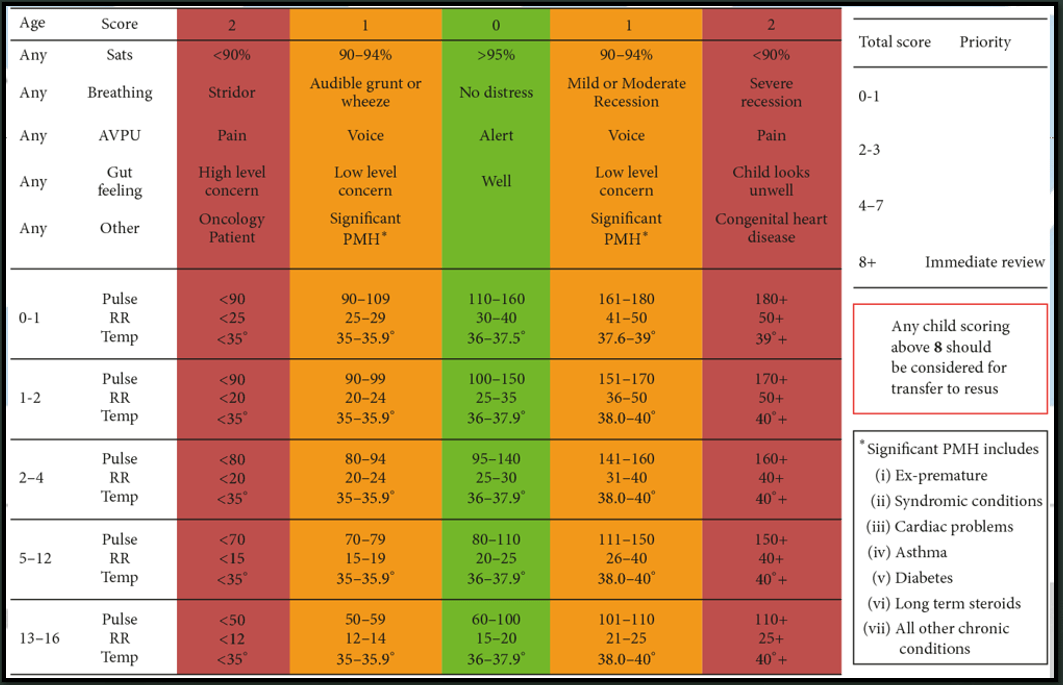
What clinical manifestations (2) are characteristic of severe sepsis?
Hypotension and signs of organ dysfunction
A mother presents with her 2 week old baby and complains the baby is not crying, "my other kids always cry when they are hungry, but she doesn't." The childs temperature is 37.2C and other vitals are within normal limits. The child seems appropriate for her age.
What ESI would you categorize this patient?
ESI 5
This is a well appearing baby and will likely only receive recommendations to follow up with pediatrician
A 35 year old female is in the urgent care after a slip and fall, with the following vitals:
- Respiratory rate: 16/min
- Oxygen saturation: 98%
- Air
- Systolic blood pressure: 108 mmHg
- Heart rate: 92/min
- Consciousness: Alert
- Temperature: 37.1 °C
What is the patients NEWS2 score?
NEWS2 = 2

A postpartum mother begins to hemorrhage, the team is performing fundal massage and the OB provider is at the bedside.
What intervention could the nurse expect to perform next?
Insert a foley catheter
A full bladder may prevent the uterus from properly contracting. Relieving the bladder along with continuous fundal massage should continue until the bleeding has stopped.
Up to what age do we complete a PEWS assessment?
16 years old
You suspect that your patient is exhibiting signs of inadequate tissue perfusion. Which of the following assessments would be most appropriate to perform?
- Evaluate the patients LOC and mental status
- Assess the patients RR and O2 saturation
- Check the patient's peripheral pulses and cap refill
- Measure patients BP
Check the patient's peripheral pulses and cap refill
evaluates adequacy of blood flow to the extremities and reflects overall tissue perfusion
"My wife called for an ambulance because my internal defibrillator gave me a shock this morning when i was eating breakfast. Really scared me! I saw my doctor a few days ago, and he changed some of my medications. Could that be why that happened?"
The patient has a significant cardiac history and reports taking multiple medications, including Amiodarone.
What ESI level would you categorize this patient?
ESI 2
This is a high risk situation, and this patient should not sit in the waiting room and wait to be seen. His defibrillator fired to correct an arrhythmia, he needs prompt evaluation.
A 60 year old male is in the urgent care with a mild headache and dizziness, with the following vitals:
- Respiratory rate: 12/min
- Oxygen saturation: 96%
- Air
- Systolic blood pressure: 188 mmHg
- Heart rate: 68/min
- Consciousness: Alert
- Temperature: 36.8 °C
What is the patients NEWS2 score?
NEWS2 = 0
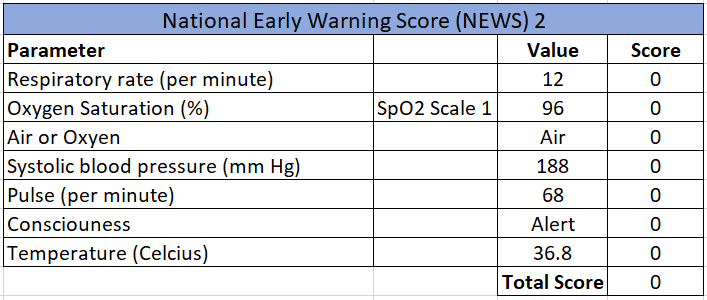
A 36-year old, 32-week pregnant patient is in the medical suite and has a MEOWS score or 0 and vital signs within normal limits on admission. The nursing assistant enters the room to round on the patient and notices the patient is sleeping and she never ate her breakfast. The nursing assistant obtains vital signs, which are within normal limits.
How should the nursing assistant proceed?
Check patient's responsiveness and notify the nurse
Pregnant patients are a vulnerable population and susceptible to clinical deterioration. The nursing assistant notices a possible change in status as the patient is sleeping and did not eat. Any change in status warrants immediate escalation to the nurse, even if the vital signs are normal.
The nurse should reassess the patient and obtain a new MEOWS.
What abnormal vital sign warrants immediate intervention and escalation for a patient less than three months old?
Temperature
Abnormal temperatures in a patient less than three months old warrants immediate intervention and escalation. Immune systems are susceptible to infection during this stage of development. Patient is a great risk for deterioration requiring aggressive sepsis protocols to be initiated.
What interventions can the nursing team expect for a patient in septic shock?
Possible interventions include:
- Frequent monitoring
- Labs
- Blood cultures
- IV fluid resuscitation
- Antibiotics
- Vasopressors
- Intubation
A patient requires the following: CBC, UA, PO medications, and crutches.
How many resources will this be?
1
CBC and UA count as one resource. PO medications and crutches are not resources.
A 29 year old male is admitted with a kidney pain and dizziness, with the following vitals:
- Respiratory rate: 25/min
- Oxygen saturation: 96%
- Air
- Systolic blood pressure: 156 mmHg
- Heart rate: 110/min
- Consciousness: Alert
- Temperature: 38.2 °C
What is the patients NEWS2 score?
NEWS2 = 5
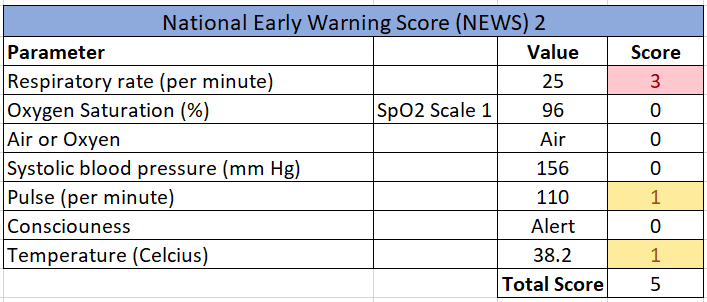
The nurse is performing a MEOWS assessment on a pregnant patient. Below are the vital signs:
- RR: 16
- SaO2: 95%
- HR: 110
- BP: 150/98
- Urine output: none
- Temperature: 37C
- Neuro: Alert
- LOC: Air
What is the MEOWS score?

a 10 month old male is lethargic and vital signs are the following:
- HR: 55
- RR: 8
- SaO2: 88%
What is immediate action can the nurse take?
Provide positive pressure ventilations
Respiratory arrest often precedes cardiac arrest in the pediatric population. Applying oxygen is the first intervention, along with escalating to the physician. If the heart rate does not improve within 60 seconds post oxygen administration, begin chest compressions.